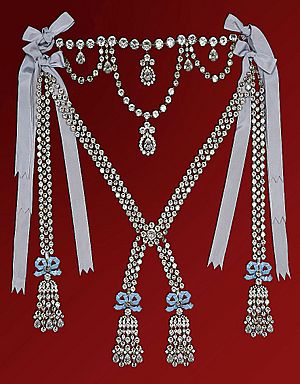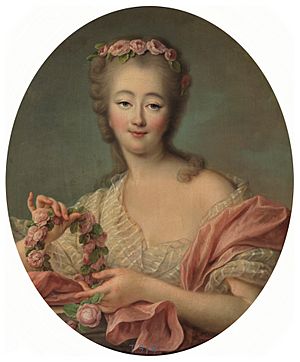Madame du Barry facts for kids
Quick facts for kids
Jeanne Bécu,
Countess of Barry |
|
|---|---|

Madame du Barry
|
|
| Born | 19 August 1743 Vaucouleurs, France
|
| Died | 8 December 1793 (aged 50) |
| Occupation | Official Mistress to Louis XV |
| Spouse(s) | Count Guillaume of Barry |
| Parent(s) | Anne Bécu Jean Baptiste Gormand de Vaubernier |
Jeanne Bécu, Comtesse du Barry (19 August 1743 – 8 December 1793) was the last chief royal mistress of King Louis XV of France. She was executed by guillotine during the French Revolution due to accounts of treason—particularly being suspected of assisting émigrés to flee from the Revolution.
Contents
Relationship with king Louis XV: 1768–1774
After the king took a great interest in her, Jeanne quickly became a sensation in Paris. She wore extravagant gowns of great proportions both in creation and cost.
In 1772, Louis XV requested that Parisian jewellers Boehmer and Bassenge create an elaborate and spectacular jeweled necklace for Jeanne—one that would surpass all known others in extravagance—at an estimated cost of two million livres.
While Jeanne was known for her good nature and support of artists, she grew increasingly unpopular because of the king's financial extravagance towards her. She was forever in debt despite her huge monthly income from the king.
She remained in her position until the death of Louis XV.
Exile: 1774–1792
Following the death of the king and his grandson's ascension to the throne as Louis XVI, Marie Antoinette had Jeanne exiled to the Abbey du Pont-aux-Dames near Meaux-en-Brie.
Imprisonment, trial and execution: 1792–93
Jeanne's Bengali slave Zamor, along with another member of du Barry's domestic staff, had joined the Jacobin club. He became a follower of the revolutionary George Grieve and then an office-bearer in the Committee of Public Safety. Jeanne found out about this in 1792 and questioned Zamor about his connections with Grieve. Upon realising the depth of his involvement, she gave him three days' notice to quit her service. This Zamor did without hesitation, and promptly proceeded to denounce his mistress to the committee.
Based largely on Zamor's testimony, Madame du Barry was suspected of financially assisting émigrés who had fled the French Revolution. Madame du Barry was finally arrested in 1793. When the Revolutionary Tribunal of Paris accused her of treason and condemned her to death, she vainly attempted to save herself by revealing the location of the gemstones she had hidden.
On 8 December 1793, Madame du Barry was executed by guillotine on the Place de la Révolution. She was buried in the Madeleine Cemetery, like many others executed during the Reign of Terror, including Louis XVI and Marie Antoinette.
Although her French estate went to the Tribunal de Paris, the jewels she had smuggled out of France to England were sold at an auction at Christie's in London, in 1795. Colonel Johann Keglevich, a brother of Major General Stephan Bernhard Keglevich, took part in the Battle of Mainz in 1795 with Hessian mercenaries, who were financed by the British with the money from this sale.
Gallery
-
Madame du Barry, by Élisabeth-Louise Vigée Le Brun (posthumous, between 1789 and 1805)
-
Jean-Michel Moreau the Younger, Fête donnée à Louveciennes le 2 septembre 1771, Musée du Louvre, Paris
-
Marble bust of Madame du Barry by Augustin Pajou, 1773, National Museum in Warsaw
-
The diamond necklace commissioned by Louis XV for Madame du Barry
-
Madame du Barry being taken away to the scaffold, by Tighe Hopkins, The Dungeons of Old Paris, 1897
Images for kids
-
Madame du Barry, by Élisabeth Vigée Le Brun; posthumous, between 1789 and 1805. Vigée Le Brun began working on the portrait in 1789, but had to abandon it when she went underwent exile the same year, due to the French Revolution. Eventually, the portrait was given back to Vigée Le Brun, who completed it and gifted it to her niece.
See also
 In Spanish: Madame du Barry para niños
In Spanish: Madame du Barry para niños













